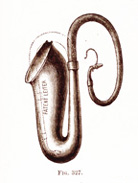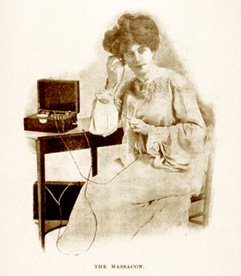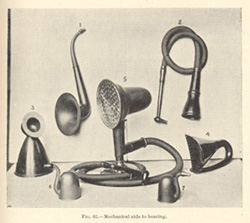Rare Books on Deafness, Hearing, and Hearing Devices
Adam Politzer (1835-1920). Politzer’s text-book of the diseases of the ear and adjacent organs: for students and practitioners / translated by Oscar Dodd; edited by Sir William Dalby. Philadelphia: Lea Brothers & Co.; London: Baillière, Tindall and Cox, 1894.
“The number of those who prize ease of social intercourse so highly that they pay no regard to the discomfort and conspicuousness of large ear-trumpets is very small. Nonewithstanding the advantages possessed by large instruments, they are generally discarded on account of conspicuousness in use. The ideal of all deaf people has always been a small instrument which could be worn unobservedly in the ear, and render at the same time the same service as the largest instrument. This problem has not yet been solved, and will not be so easily.”
Seth Scott Bishop (1852-1923). The ear and its diseases: a text-book for students and physicians. Philadelphia: F. A. Davis Company, 1906.
“No efficient and harmless hearing-instrument for wearing in the ear has yet been devised. Fame and fortune await the inventor of the aural equivalent of spectacles.”
Bishop recounts a conversation with Alexander Graham Bell where Bell related that his discovery of the telephone was related to trying to invent a microphone to aid the deaf. Bishop asked Bell if it were possible to construct an instrument for defective hearing comparable to the lens for defective vision. Bell replied, “I will not say that it is impossible, but in the present state of our knowledge, it is improbable.”
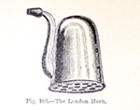 |
According to Bishop only two hearing devices have proven to be of any practical value. The two are the London Horn and the conical conversation tube as illustrated in Bishop’s work. | 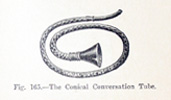 |
Evan Yellon. Surdus in search of his hearing: an exposure of aural quacks and a guide to genuine treatments and remedies electrical aids, lip-reading and employments for the deaf etc., etc. London: Celtic Press, 1906.
Yellon’s work contains rare photographs taken at the turn of the 20th century that show people wearing and using hearing devices.
 |
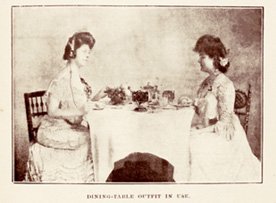 |
| This photograph shows the Acousticon Desk Outfit in use. | This photograph shows the Acousticon Dining Table Outfit in use. |
“To the sufferer from semi-deafness, an otoacoustical instrument, no matter what its form may be, offers one great objection, namely, it is more or less conspicuous, and immediately draws attention to the user’s infirmity, usually the very thing he or she most desires to avoid. To remedy this drawback as much as is possible, the different instrument makers who specialize in aids for the deaf have placed on the market what are termed ‘disguised aids.’ They take on the form of acoustic fans, walking sticks, books, work boxes, etc. One maker exhibits in his shop window a grand acoustic easy chair, elegantly gilded and nicely upholstered! An invisible aid for the deaf is, as yet, a dream of the remote future, and fair fortune awaits its lucky inventor. Now and again we meet with advertisements of so-called invisible aids for the deaf, but investigation invariably reveals them to be simply tiny trumpets, of value only to keep a closed orifice open; or as artificial ear-drums . . . such advertisements are snares for the unwary and should be regarded with suspicion.”
Thomas Barr (1846-1916). Manual of diseases of the ear. Glasgow: James Maclehose and Sons, 1909.
William Guthrie Porter (d. 1917). Diseases of the throat, nose, and ear. Bristol: John Wright & Sons, 1912.
Theodore Heiman (b. 1848). L’oreille et ses maladies. Paris: Steinheil, 1914.
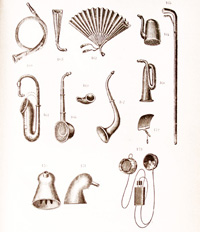 |
Heiman’s work from 1914 contains illustrations of hearing devices, including an early electronic device. |
Max Aaron Goldstein (1870-1941). Problems of the deaf. St. Louis: The Laryngoscope Press, 1933.
Problems of the Deaf is among the premier classic works in the field of deaf education covering a wide range of material related to deafness including anatomy and physiology, research in deafness, rare books, quackeries, hearing devices, phrenology, speech defects, lip-reading, to name a few. Goldstein stated in the foreword that his real inspiration in writing this book was the thought that had activated the best and happiest years of his life: “help the handicapped child.”
| These two hearing devices, a Natural Concha Shell trumpet and an Aurolese Opera Comb by F. C. Rein, were once part of the CID-Goldstein Historic Devices for Hearing Collection (now missing). | 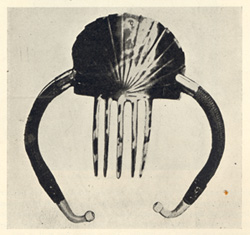 |
<< Previous | 1 | 2 | 3


